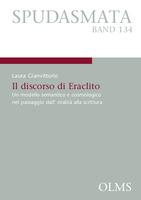Il discorso di Eraclito
Un modello semantico e cosmologico
Author(s)
Gianvittorio, Laura
Collection
Austrian Science Fund (FWF)Language
ItalianAbstract
Since the “scuola urbinate” (e. g. B. Gentili) applied the oral theory to the Greek lyricists, orality is seen to have influenced thought and language not only of rhapsodists, but of archaic authors in general. Against this background, I investigate how the interaction between orality and literacy, which I suggest to call “aurality”, influences the semantics and the linguistic reasoning chiefly of Heraclitus among the early presocratic thinkers. On the one hand Heraclitus is an oral “image-thinker” (Havelock) and his prose is poetically constructed; on the other hand only by writing he can figure out the discourse (λόγος) as a ὀνόματα-composed unity, as I mean he does, rather than holistic or as a continuum, what is common in oral societies. Such a λόγος is able to serve as a cosmological model, for the physical world consisting of a multiplicity of phenomena closely jointed to each other into an invisible unity. Im allgemeinen Verständnis begründen die Vorsokratiker das philosophische Fachwissen und die philosophische Fachsprache. Diese Annahme wird in der vorliegenden
Arbeit mittels einer semantischen
Analyse revidiert: die Sprache der
Vorsokratiker meidet nicht, sondern zielt geradezu auf mehrdeutige und redundante Ausdrucksweisen. Hier ist der nicht-terminologische Gebrauch von logos bei Heraklit besonders aufschlussreich. In der Bedeutung dieses Lexems, die an den bis
zur Zeit des Ephesiers belegten Verwendungskontexten untersucht wird, zeigt sich die noch wirkende Kontinuität mit der legein- Grundbedeutung „sammeln“:
die „Rede“ besteht nämlich aus einer
Sammlung einzelner epea bzw. onomata. Aufgrund ihrer synthetischen Struktur ist
sie geeignet, eine heuristische Funktion für das menschliche Verstehen der latenten Einheit scheinbar loser Erscheinungen zu
erfüllen. Sowohl formal, in der Art, wie
das Lexem semantisch aufgeladen wird, als auch inhaltlich, in der spezifi sch herakliteischen Interdependenz zwischen Realität und Sprache, lassen sich in dem logos des
Heraklit Charakteristika erkennen, die auf den Übergang von der Mündlichkeit zur Schriftlichkeit zurückgeführt werden können.Secondo la communis opinio, i Presocratici segnano l’inizio della filosofi a come disciplina e del relativo linguaggio specialistico. Tali presupposti vengono qui messi in discussione in base ad un’analisi semantica del linguaggio presocratico:
piuttosto che ridurre, esso potenzia
ambiguità e ridondanza sfruttandole
come risorse del senso. L’esame si
concentra sull’uso non terminologico
di logos in Eraclito. Il signifi cato del
lessema, stabilito in base ai contesti
d’uso attestati fi no all’epoca dell’Efesio ed affrancato dalla successiva Wirkungsgeschichte,
è ancora contraddistinto
dall’idea del ‘raccogliere insieme’ (legein): il ‘discorso’, infatti, consiste nella sintesi di singoli epea (detti) ed onomata (nomi). Mostrando il farsi uno dei molti, il logos assume dunque una funzione euristica per la comprensione dell’unità di fenomeni apparentemente irrelati o contraddittori. Sia a livello formale, nei
modi della “ri-semantizzazione” della parola- chiave, sia a livello contenutistico, nella specifi ca interdipendenza scorta tra linguaggio e mondo, si riconoscono nel logos di Eraclito caratteristiche salienti del compromesso tra oralità e scrittura.Der Erwerb des Buches ist ,möglich: www.olms.de
Keywords
Heraclitus; logos; orality-literacy; presocratic philosophical language; semantics; cosmologyDOI
10.26530/oapen_507997ISBN
9783487143866OCN
1030813548Publisher
Georg Olms VerlagPublisher website
http://www.olms.de/Publication date and place
Hildesheim, 2010Grantor
Classification
Language and Linguistics


 Download
Download